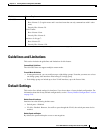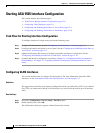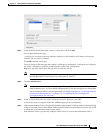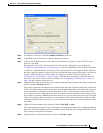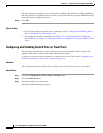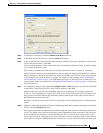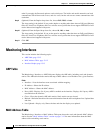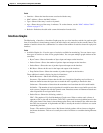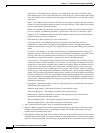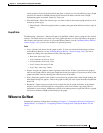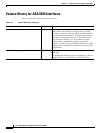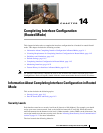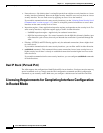
13-13
Cisco ASA 5500 Series Configuration Guide using ASDM
Chapter 13 Starting Interface Configuration (ASA 5505)
Monitoring Interfaces
Fields
• Interface—Shows the interface name associated with the entry.
• MAC Address—Shows the MAC address.
• Type—Shows if the entry is static or dynamic.
• Age—Shows the age of the entry, in minutes. To set the timeout, see the “MAC Address Table”
section on page 13-12.
• Refresh—Refreshes the table with current information from the ASA.
Interface Graphs
The Monitoring > Interfaces > Interface Graphs pane lets you view interface statistics in graph or table
form. If an interface is shared among contexts, the ASA shows only statistics for the current context. The
number of statistics shown for a subinterface is a subset of the number of statistics shown for a physical
interface.
Fields
• Available Graphs for—Lists the types of statistics available for monitoring. You can choose up to
four types of statistics to show in one graph window. You can open multiple graph windows at the
same time.
–
Byte Counts—Shows the number of bytes input and output on the interface.
–
Packet Counts—Shows the number of packets input and output on the interface.
–
Packet Rates—Shows the rate of packets input and output on the interface.
–
Bit Rates—Shows the bit rate for the input and output of the interface.
–
Drop Packet Count—Shows the number of packets dropped on the interface.
These additional statistics display for physical interfaces:
–
Buffer Resources—Shows the following statistics:
Overruns—The number of times that the ASA was incapable of handing received data to a
hardware buffer because the input rate exceeded the ASA capability to handle the data.
Underruns—The number of times that the transmitter ran faster than the ASA could handle.
No Buffer—The number of received packets discarded because there was no buffer space in the
main system. Compare this with the ignored count. Broadcast storms on Ethernet networks are
often responsible for no input buffer events.
–
Packet Errors—Shows the following statistics:
CRC—The number of Cyclical Redundancy Check errors. When a station sends a frame, it
appends a CRC to the end of the frame. This CRC is generated from an algorithm based on the
data in the frame. If the frame is altered between the source and destination, the ASA notes that
the CRC does not match. A high number of CRCs is usually the result of collisions or a station
transmitting bad data.
Frame—The number of frame errors. Bad frames include packets with an incorrect length or
bad frame checksums. This error is usually the result of collisions or a malfunctioning Ethernet
device.



